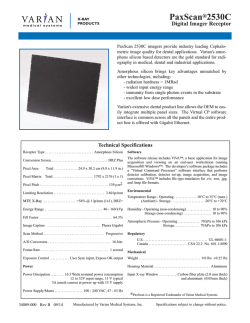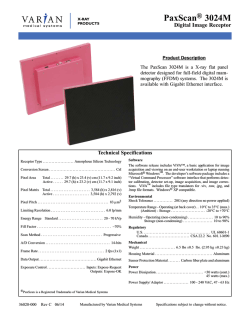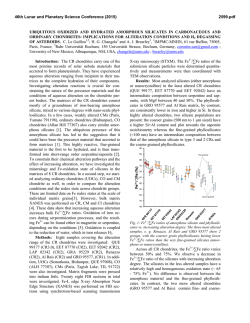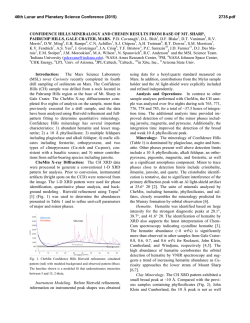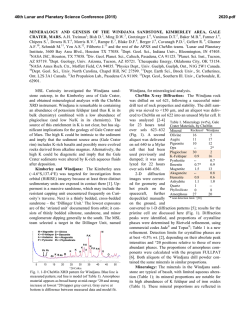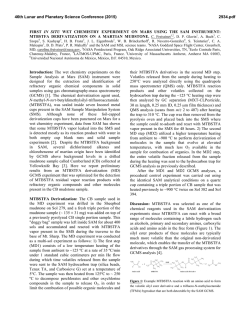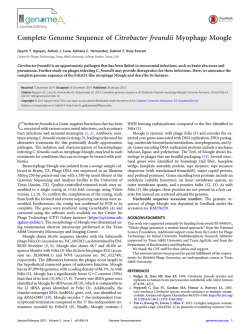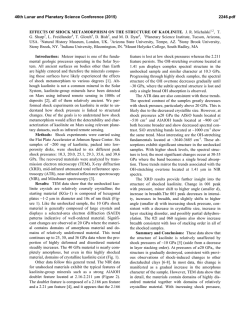
gale crater, mars
46th Lunar and Planetary Science Conference (2015) 1946.pdf THE X-RAY AMORPHOUS COMPONENTS OF THE ROCKNEST SOIL AND SHEEPBED MUDSTONE (GALE CRATER, MARS): MINIMUM ABUNDANCE, COMPOSITIONAL RANGES AND POSSIBLE CONSTITUENTS. E. Dehouck1, S. M. McLennan1, P.-Y. Meslin2, A. Cousin2,3, and the MSL science team. 1 Department of Geosciences, Stony Brook University, NY, USA ([email protected]); 2IRAP, UPS/CNRS/OMP, Toulouse, France; 3LANL, Los Alamos, NM, USA. Introduction: The Mars Science Laboratory rover Curiosity is the first martian spacecraft equipped for X-ray diffraction (XRD) analysis, which is the most common method used on Earth to identify minerals in bulk geological samples. The diffractometer is part of the CheMin instrument [1], which receives <150-µm powder samples from the sample collection and processing subsystem on the rover arm. During the first (terrestrial) year of the mission, CheMin analyzed samples from three locations: the Rocknest sand shadow (scooped) [2,3], and the John Klein (JK) and Cumberland (CB) outcrops (drilled) [4]. Both JK and CB are part of the Sheepbed mudstone, which is itself the lowest exposed member of the fluvio-lacustrine Yellowknife Bay formation [5]. In terms of mineralogy, the Sheepbed mudstone differs from the Rocknest sand mainly by the presence of abundant smectite clays, as well as lower abundance of olivine and greater abundance of magnetite, suggesting that the Sheepbed mudstone has been modified by aqueous alteration during diagenesis [4-6]. Otherwise, the samples share a number of compositional characteristics: both contain a significant X-ray amorphous component in addition to several primary basaltic minerals [2-4]. Here, we present the results of mass balance calculations that provide constraints on the abundance and explore the domain of possible chemical compositions of the amorphous components detected in the Rocknest sand and the Sheepbed mudstone [7]. Methods: Following an approach similar to [8], we based our calculations on bulk chemical compositions measured by the APXS instrument, and on phase abundances and structural formulas derived from the CheMin XRD patterns by [2-4]. Using the Scilab software, we developed a program that calculates all the possible chemical compositions of the crystalline component – and thus of the complementary amorphous component – of each sample, taking into account the uncertainties on the phase abundances derived from CheMin data [2,4]. For the Sheepbed mudstone, we chose to work only with the data from the CB drill in order to minimize the potential effect of cross-sample (i.e., Rocknest-JK) contamination [4]. We have explored a range of values between 10 and 50 wt% of amorphous component but, for more detailed analyses, we have focused on the two follow- ing values: 30 wt% ̶ close to the XRD-based estimates [2,4] ̶ and 45 wt% ̶ close to the amount estimated by [8] for Rocknest. In some cases, the calculated amorphous component may have one or more oxides with concentrations below 0 wt%: the combination is then “chemically unrealistic” and thus rejected by the program. Therefore, this constraint can be used to determine a lower limit to the overall abundance of the amorphous component, i.e., the minimum amount required to have all oxides ≥0 wt% (Fig. 1). Results: Rocknest soil. The minimum abundance of amorphous component for Rocknest is 22 wt% (Fig. 1). In addition, proportions below 25 wt% are considered as unlikely, because less than 5% of the calculated combinations are retained. These abundances are significantly higher than the lower limit (~14 wt%) and in good agreement with the best estimate (~27 wt%) derived from the XRD pattern [2]. Sheepbed mudstone. In the case of the Sheepbed mudstone, the composition of the smectite clay adds additional uncertainty to the estimate of the composition of the crystalline and amorphous components [4]. Based on detailed XRD comparisons, [9] showed that the best known terrestrial analog for the smectite clay of the Sheepbed mudstone is a ferrian saponite from Griffith Park (Los Angeles, CA). Because this analog has somewhat varying compositions from one sample to another, we used two different compositions published by [9], referred here as Griffith saponite 1 and 2. The minimum abundance of amorphous component of Sheepbed is 15 wt% with smectite as Griffith saponite 1 and 18 wt% with smectite as Griffith saponite 2 (Fig. 1). Proportions below 21 and 24 wt%, respectively, are considered as unlikely (i.e., less than 5% of the combinations are retained). These values are somewhat higher than the lower limit (~12 wt%) and in good agreement with the best estimate (~31 wt%) derived from the XRD pattern [4]. Comparison between Rocknest and Sheepbed. The X-ray amorphous components of Rocknest and Sheepbed have striking compositional similarities: their calculated SiO2, TiO2, Al2O3, Cr2O3, FeO, CaO, Na2O, K2O and P2O5 concentrations are within comparable ranges [7]. The only oxide for which there is strictly no overlap, whatever the amounts of amorphous component in the two samples, is SO3: it is always higher in 46th Lunar and Planetary Science Conference (2015) Rocknest than in Sheepbed. Several hypotheses can be considered to explain this difference: (1) the two amorphous components were formed with different concentrations of S; (2) the two were formed with comparable concentrations but (2a) S was later added to the amorphous component of Rocknest, or (2b) S was later removed from the amorphous component of Sheepbed. Sulfur mobility on Mars can be demonstrated by the observation of numerous Ca-sulfate-filled veins at Gale [6] and elsewhere on Mars [10]. Thus, one possibility is that some S originally present in the amorphous component of Sheepbed has been remobilized by the late diagenetic event that formed the Casulfate veins, and incorporated in the latter (hypothesis 2a). Alternatively, S may have been added to the amorphous component of Rocknest in the form of amorphous sulfates (or sulfites) transported from a nearby source [e.g., 11] or in the form of adsorbed SO42- [12] (hypothesis 2b). The MgO concentration tends to be higher for the amorphous component of Sheepbed, although there is still some overlap in the case of Griffith saponite 1 (or any other clay mineral with equivalent or higher MgO content). In any case, this suggests no Mg loss – or even an enrichment – compared to Rocknest, which is consistent with the hypothesis that olivine was the main source of Mg to form the saponitic clay [4]. Conclusion and future work: Our mass balance calculation program provides the minimum abundances required for the amorphous component to have realistic chemical compositions (i.e., all oxides ≥0 wt%). These minimum abundances are ~22 wt% for Rocknest and ~15 to 18 wt% for Sheepbed (CB drill), in good agreement with estimates derived from the XRD patterns [2,4]. In addition, our results show that, apart from S, the amorphous component of Rocknest and Cumberland are chemically very similar based on our current knowledge of these samples, pointing toward a common origin and/or a common formation process. Although more investigations will be necessary to formally identify them, the individual phases possibly present within the amorphous components include: volcanic (or impact) glass, hisingerite, amorphous silica, ferrihydrite (or other nanophase ferric oxides) and amorphous sulfates (or adsorbed SO42-) [7]. In future work, we plan to test the relative stability of the above-mentioned “candidate” amorphous phases using a modified version of the experimental device described by [13]. We will investigate the influence of temperature, relative humidity and atmospheric composition on the recrystallization process in order to evaluate the likelihood of preserving amorphous components on long timescales at Gale, either at the surface or after possible burial under the sediments of Aeolis Mons. 1946.pdf References: [1] Blake D. et al. (2012) Space Sci. Rev., 170, 341-399. [2] Bish D. L. et al. (2013) Science, 341, DOI: 10.1126/science.1238932. [3] Blake D. et al. (2013) Science, 341, DOI: 10.1126/science.1239505. [4] Vaniman D. et al. (2014) Science, 343, DOI: 10.1126/ science.1243480. [5] Grotzinger J. P. et al. (2014), Science, 343, DOI: 10.1126/science. 1242777. [6] McLennan S. M. et al. (2014) Science, DOI: 10.1126/ science.1244734. [7] Dehouck E. et al. (2014) JGRPlanets, 119, DOI:10.1002/2014JE004716 [8] Morris R. V. et al. (2013) LPSC XLIV, abstract #1653. [9] Treiman A. H. et al. (in press) Am. Min. [10] Squyres S. W. et al. (2012) Science, 336, DOI: 10.1126/science. 1220476 [11] Wang A. and Ling Z. C. (2011) JGR-Planets, 116, DOI: 10.1029/2010JE003665 [12] McAdam et al. (2014) JGR-Planets, 119, DOI : 10.1002/ 2013JE004518. [13] Zhao Y.-Y. S. (2013) LPSC XLIV, abstract #3002. Figure 1 – Percentage of realistic combinations (i.e., compositions with all oxides ≥0 wt%) as a function of the proportion of amorphous component in the bulk sample for Rocknest (A) and Sheepbed/Cumberland (B). Total number of combinations is 59,049 for Rocknest and 1,417,176 for Cumberland [7].
© Copyright 2026
